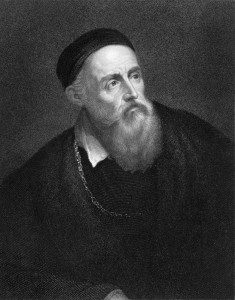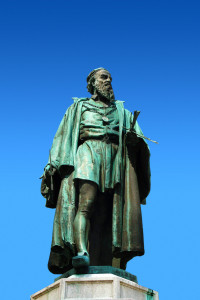 Tiziano Vecellio (better known as Titian in the Anglosphere) was born in the Italian town of Pieve di Cadore in the late 1480s. His father, Gregorio Vecellio, had many duties around the city, which included managing mines and taking care of the town’s castle. When Titian was only in his teens, he was sent off to study painting in Venice under the great Renaissance master Giovanni Bellini. It was in Bellini’s workshop that Titian became acquainted with many local painters, especially Giorgio da Castelfranco (aka Giorgione).
Tiziano Vecellio (better known as Titian in the Anglosphere) was born in the Italian town of Pieve di Cadore in the late 1480s. His father, Gregorio Vecellio, had many duties around the city, which included managing mines and taking care of the town’s castle. When Titian was only in his teens, he was sent off to study painting in Venice under the great Renaissance master Giovanni Bellini. It was in Bellini’s workshop that Titian became acquainted with many local painters, especially Giorgio da Castelfranco (aka Giorgione).
Titian’s Teacher & Rival | Giorgione
After Titian left Bellini’s school in 1507, he worked with Giorgione on various projects around the “City of Bridges.” Unfortunately, many of Titian and Giorgione’s frescos in Venice have been completely destroyed due to weather. During this time, there was apparently a great deal of rivalry between the two painters. This rivalry intensified when locals started to notice slight differences between the two artists’ styles. During the early 1500s, Tiziano’s style of painting was still highly indebted to Giorgione, which makes it extremely difficult for art critics to tell who did what painting. The most recent high profile “flip-flop” on this issue concerned the painting Christ Carrying the Cross at the Scuola Grande di San Rocco. This oil painting, completed in 1505, was considered to be by Giorgione for many years. Today, however, popular critical opinion sways towards attributing this painting to Titian. Believe it or not, this issue surrounding Giorgione/Titian paintings has become such a big deal that playwright Simon Gray wrote a whole drama about it called The Old Masters.
Titian Finds His Place
It wasn’t really until the years 1516-1530 that Tiziano established his unique genius in the Venetian art world. By that time, both Giorgione and Bellini had died, which instantly made Titian the most famous artist in all of Venice with virtually no competition. Titian started to get bolder with both the size of his paintings and his more aggressive brushstrokes. It was during this time that Titian produced perhaps his most celebrated work: Assumption of the Virgin (1518). Completed in only two years time, this massive altarpiece at the Basilica di Santa Maria Gloriosa dei Frari measures an astonishing 270 inches by 140 inches. The painting is famously split into three sections: apostles on the ground look up towards the central Virgin Mary as angels lift her up towards God at the top. The size and striking use of colors in the Assumption cemented Titian’s name as a master of Italian Renaissance art.
Titian Breaks Convention | Straying From Fresco
Titian is particularly well known for breaking with the convention of soft fresco paintings fashionable with artists like Bellini. Instead, Tiziano favored oil canvass paintings and he used brushstrokes  and colors to express emotion through the paint rather than just the scenes depicted. Many of Titian’s oil canvasses drip with Venetian opulence and sensuality, thanks in large part to his skillful depiction of human skin. Indeed, the grand tradition of “the nude” in Western oil painting owes a great debt to Tiziano. Just as one example, French Impressionist Édouard Manet’s scandalous painting of a prostitute Olympia (1863) was directly modeled on Tiziano’s 1538 Venus of Urbino.
and colors to express emotion through the paint rather than just the scenes depicted. Many of Titian’s oil canvasses drip with Venetian opulence and sensuality, thanks in large part to his skillful depiction of human skin. Indeed, the grand tradition of “the nude” in Western oil painting owes a great debt to Tiziano. Just as one example, French Impressionist Édouard Manet’s scandalous painting of a prostitute Olympia (1863) was directly modeled on Tiziano’s 1538 Venus of Urbino.
Although Tiziano Vecellio died in 1576, his importance to Western art has only increased with age. Just a few artists indebted to Titian’s work include Rembrandt, El Greco, and Peter Paul Rubens. Along with Bellini, Tintoretto, and Giorgione, Titian is one of Venice’s undisputed artistic geniuses.

